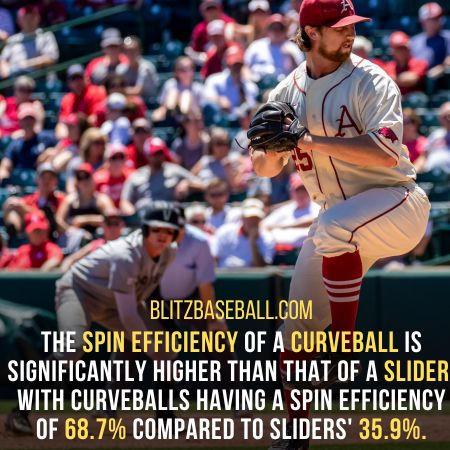In the world of Major League Baseball, two pitches that have gained popularity and proven effectiveness are the slider and the curveball. Both pitches possess distinct characteristics and techniques that set them apart.
This article aims to provide a comprehensive understanding of what is the difference between a slider and a curveball, offering insights from a knowledgeable coach.
The slider, with its gripping technique involving the index and middle fingers at the top of the ball and the thumb beneath, exhibits greater velocity and minimal movement.
On the other hand, the curveball, introduced in 1870 by Fred Goldsmith, utilizes a grip where the middle finger is placed along the bottom seam and the thumb on the back seam.
Known for its slower speed and significant movement, the curveball has been a prominent pitch in the repertoire of pitchers like Sandy Koufax and Bert Blyleven.
By delving into the definition, basics, pitching techniques, and effects of these pitches, this article aims to shed light on the intricacies and nuances that differentiate the slider from the curveball.
Key Takeaways
- The curveball is a breaking pitch with more movement and slower speed, while the slider is faster with less movement.
- The grip is a key difference between the curveball and slider, with the curveball grip having the middle finger along the bottom seam and the thumb on the back seam, while the slider grip has the index and middle finger at the top of the ball and the thumb beneath.
- Both the slider and curveball can cause strain and injuries on the arm, especially the elbow and shoulder.
- Famous pitchers known for the curveball include Sandy Koufax and Bert Blyleven, while famous pitchers known for the slider include Randy Johnson and Steve Carlton.
Difference Between A Slider And A Curveball

The key difference between a slider and a curveball lies in their respective grips. The curveball is thrown with the middle finger along the bottom seam and the thumb on the back seam, while the slider is thrown with the index and middle finger at the top of the ball and the thumb beneath it.
This variation in grip greatly affects the movement and speed of the pitches. Famous pitchers have their own preferences when it comes to these pitches. Pitchers like Sandy Koufax, Bert Blyleven, Dwight Gooden, and Camilo Pascual are known for their exceptional curveballs.
On the other hand, Randy Johnson, Steve Carlton, Bob Gibson, and Sparky Lyle are renowned for their deadly sliders. These pitchers have mastered the art of throwing these best pitches, using their unique grips to deceive and confuse batters.
Grip variations play a crucial role in the effectiveness of these pitches and contribute to the success of these accomplished pitchers.
Definition and Basics
Spin efficiency is a crucial factor in differentiating the movement of a slider and a curveball in Major League Baseball.
The spin efficiency of a curveball is significantly higher than that of a slider, with curveballs having a spin efficiency of 68.7% compared to sliders’ 35.9%. This difference in spin efficiency contributes to the distinct movement of each pitch.
Here are some key points to consider about the grip variations and famous pitchers associated with these pitches:
-
Grip variations:nnThe grip for a curveball involves placing the middle finger along the bottom seam of the ball, with the thumb positioned on the back seam. On the other hand, the grip for a slider requires the index and middle finger to be placed at the top of the ball, while the thumb is positioned beneath it.
-
Famous pitchers: some notable pitchers known for their curveballs include Sandy Koufax, Bert Blyleven, Dwight Gooden, and Camilo Pascual. On the other hand, Randy Johnson, Steve Carlton, Bob Gibson, and Sparky Lyle are renowned for their slider pitches.
-
These grip variations and the techniques employed by these famous pitchers contribute to the unique movement and effectiveness of their respective pitches.

Pitching Techniques
Pitching techniques for slider and curveball pitches involve specific grip variations and throwing motions. Coaches can train the pitchers with pitching drills.
The common grip for a curveball is to place the middle finger along the bottom seam of the ball, with the thumb on the back seam. On the other hand, the grip for a slider involves placing the index and middle finger at the top of the ball, with the thumb beneath. These grips are essential for generating the desired movement and velocity of each pitch.
When it comes to pitch selection strategies, pitchers consider factors such as the hitter’s weaknesses, their own strengths, and the game situation. It is important to choose the pitch that suits the pitcher’s abilities and can effectively deceive the hitter.
Mastering the correct grip and understanding pitch selection strategies are crucial for achieving success with the slider and curveball pitches.
Effects and Differences

Effects and differences between these pitches can greatly impact a pitcher’s success and a hitter’s ability to make contact. Understanding the advantages and disadvantages of each pitch is crucial for pitchers and hitters alike.
-
The curveball, with its slower speed and greater movement, can deceive hitters and make it difficult to make solid contact. However, its effectiveness is dependent on factors like wind speed and weather conditions, making it less reliable in certain situations.
-
On the other hand, the baseball slider, with its faster speed and lesser movement, can be more challenging for hitters to track and time. It is generally considered a better pitch due to its breaking capability and velocity.
-
Common grip mistakes for the curveball include improper finger placement, which can affect the spin and movement of the pitch.
-
For the slider, a common mistake is not maintaining consistent finger pressure, leading to inconsistent break and control.
Understanding these effects and differences can help pitchers optimize their pitches and hitters anticipate the movement and timing of each pitch.
